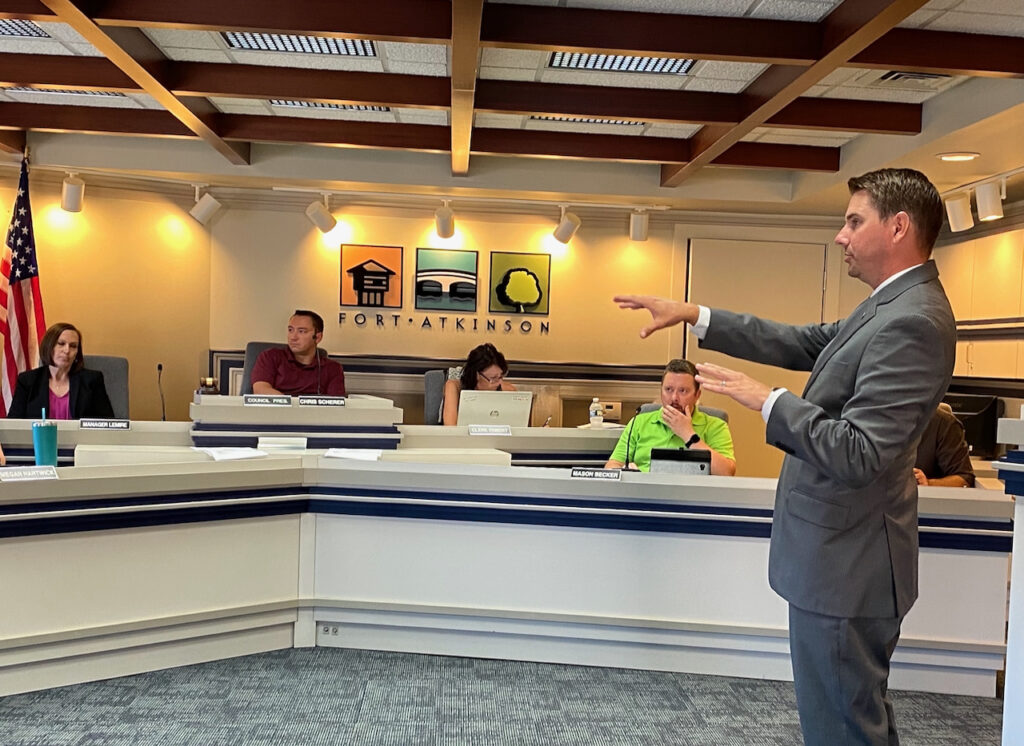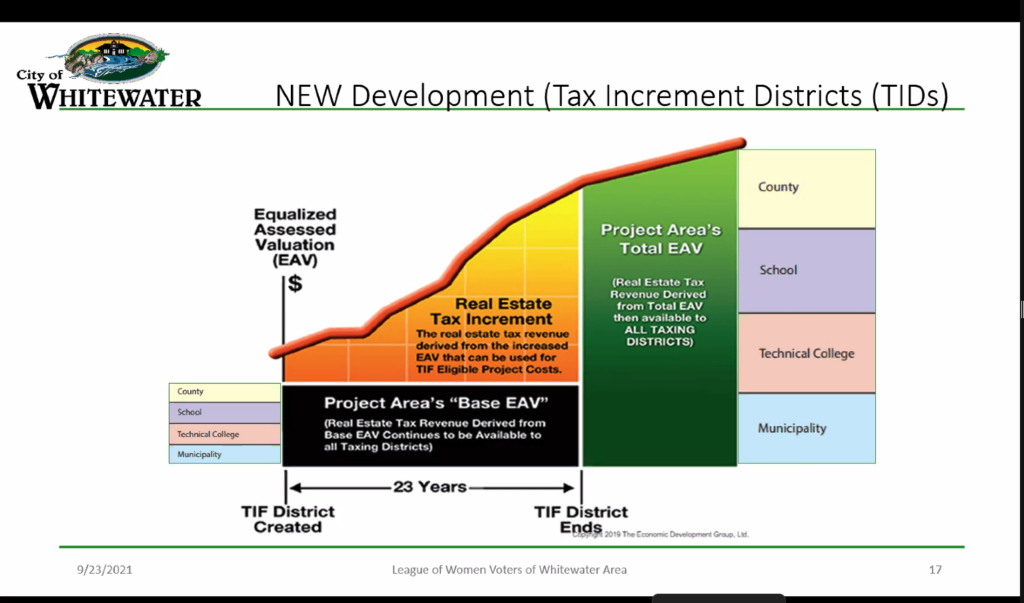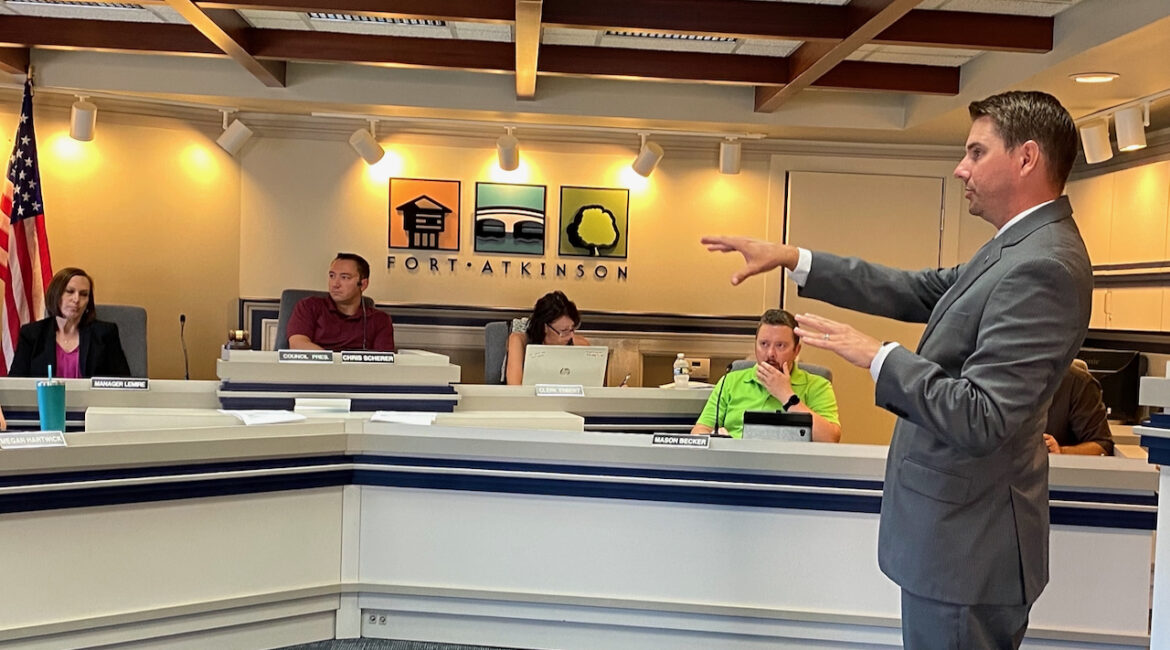Editor’s note: Following is the first of a two-part story about Tax Incremental Financing and districts under development in Fort Atkinson using the economic development tool.
By Ryan Whisner
In anticipation of plans to develop at least two new tax incremental financing districts (TIDs), the Fort Atkinson City Council recently received a brief refresher on tax increment financing (TIF) from its financial advisor.
The economic development tool is used by municipalities throughout the state to help attract development in designated areas that qualify, Justin Fischer — a representative of Baird, a financial advisory firm contracted by the city — noted Tuesday, Sept. 6. During a workshop held in advance of the council’s regular meeting, Fischer presented what he termed “TIF 101.”
Currently there are over 1,300 active tax incremental financing districts in Wisconsin, Fischer said.
“This is not something that’s new or rarely used by Wisconsin communities. It’s definitely the number one economic development tool available to Wisconsin municipalities and that’s why it’s so widely used, because for a municipality, you want to see your community grow, you want to see good things come to your constituents, and a lot of that requires you to bring in these new developments, but the question is always: How?” he said.
Fischer pointed out that where many people get lost is when they have a mistaken belief that creation of the tax increment district means new development will occur immediately. Unfortunately, that’s not quite how it works, he said.
“It takes a lot of marketing efforts to raise awareness and ultimately, it takes time to get the infrastructure in place. After that first development arrives, people start getting excited about it and then all the ancillary developments start coming in,” Fischer said.
Using the TIF structure as a tool, development occurs over the course of the TID’s “open” period. While the TID is open, it generates tax revenue, which can then be used by the city to recoup expenditures accrued within the TID during its development phase.
Offering further explanation, Fischer began his presentation with a brief glossary of terms.
The financial consultant explained that tax incremental financing, or “TIF,” is the economic tool or the program utilized by a municipality.
“It’s a ‘but, for’ test,” Fischer said, gauged by asking the question: “If we don’t create this tax increment district will development come?
“If you truly believe that development will come, you probably shouldn’t set up a tax increment district. If you truly believe it’s going to take incentives to get the developments that you believe you want for your community, that’s where the tax increment financing program makes sense.”
Conversely, the tax increment district, or “TID,” is the actual contiguous boundary of the district.
“You’re freezing a value of a portion of a property or multiple properties,” Fischer said, noting that it impacts all taxing jurisdictions within the district. Ultimately, the goal of the concept is to bring in value within that boundary that would not be there had the TID not been created.
Additionally, he said, the city has a few different types of TIDs that it can implement once the decision is made to utilize the tool.
The first, Fischer said, is a blight, rehabilitation and conservation TID.
“A blight or rehabilitation TID is ultimately exactly what it sounds like; it is an area that is dilapidated that you really think has been abandoned, that you truly believe that it’s going to take some time for a particular site to get back up on its feet,” he said. “Those types of tax increment districts are allowed to stay open for 27 years, because it takes a long time, especially up front, to potentially get that area back to usable space where development may want to come.”
A second type is defined as industrial, created as a tool to help develop industrial parks.
The final type is called “mixed use,” which, Fischer said, gives a municipality the most flexibility as far as what types of developments can be included.
“Think of it as having apartments with retail and all sorts of different amenities for that district,” he said.
Fischer next sought to explain the funding process, which, he said, often garners the most confusion.
“The tax revenue is used to help offset and pay for any project costs that (it) took the city to get to that point,” Fischer said.
He cited infrastructure costs as an example of the types of costs the city can offer as an incentive to attract larger developments to build in an industrial park, with those assets ultimately generating tax revenue for much longer than the life of the TID.
When a municipality creates a TID, it has a base equalized value (defined as the equalized value of the property within the boundaries of that TID at the time the district was frozen). Fischer said that once a TID is created, any value generated above that base value is called the “increment.” For example, if an undeveloped property sells for $100,000, but after development, the land and its assets are valued at $1 million, there is a $900,000 increase in that property’s value, which is then called the increment value.
There are at least two options, or some combination thereof, the city can use when evaluating how to address its costs in financing TID projects, Fischer said.
Using the first method, the city pays upfront. As an example, Fischer said, if a big developer comes in with a plan, it may suggest to the city that it is easier for the city to take on the infrastructure costs.
“That may be the case to get the infrastructure in place, as the city may need to borrow,” he said. “From a finance perspective, there are strategic methods to keep from putting those dollars on the tax levy,” he added.
The consultant noted that borrowing is not his preferred method when developing a TID.
“I don’t want you borrowing if you don’t need to, but it may be necessary in some respects, because the developer obviously wants you to take that (infrastructure costs) on versus himself,” Fischer said. “They’d rather have you pay for it than necessarily them going out and using all their money to do that.”
A second option is the “pay as you go” model.
Fischer said a negotiation between the city and the developer to use this option is often, from the municipality’s perspective, a better approach. Under this option, the developer makes the up-front investments in the project and once it reaches the terms of the developer’s agreement — in terms of generation of tax revenues — it receives a certain percentage of that tax revenue back to a certain amount.
“They (the developers) won’t ever get anything from you (the city) unless they actually generate tax revenue,” Fischer said. “I think that’s where, unfortunately, you hear a lot of things in the paper that aren’t necessarily accurate, because a lot of agreements are set up so (the) city won’t be on the hook, unless they (the developer) actually produce.”
He said the city can do combinations of those financing methods to come up with strategies for project development. One project may not be as attractive as another, so the incentive packages might vary from one development to another.
“As long as we can get it financially to cashflow and be feasible, the developer’s agreements can be tightened up,” Fischer said. “Ultimately it comes down to you, and how you feel about the development, and what type of incentive package you’re comfortable with,” he added.

Justin Fischer, at right, a representative of Baird, a financial consulting firm contracted by the city of Fort Atkinson, offers a tax incremental financing refresher he dubbed “TIF 101,” during a workshop attended by Fort Atkinson City Council members in advance of their meeting held Sept. 6. Ryan Whisner photo.

The above graphic, which was presented within a story published by Fort Atkinson Online about TIDs last year as part of an explanation of TIF in a neighboring community, provides a generalized depiction of how tax incremental financing districts work. Colored rectangles on the left side of the graphic represent tax dollars collected by various taxing jurisdictions — including the county, school district, technical college and municipality — at the time when the the Tax Incremental Financing District (TID) boundaries are created, and the value within the district is frozen, creating the district’s base value. Corresponding colored rectangles on the right side of the graphic represent the increase in tax dollars collected by the jurisdictions after the TID attracts developers who build assets that increase the value of the overall district. Increments can be used to fund incentives for development, such as infrastructure costs, within the district while it remains open.
This post has already been read 2347 times!
